All You Need to Know About HR Digital Transformation in the Financial Sector
Updated: August 19, 2021
Within modern HR, employees and data are the two most precious assets. To make the most of both, financial companies need an HR digital transformation strategy. Such a strategy marries human resources with the data a company possesses, allowing businesses to achieve agility, enhance performance, and generate an appealing brand image.
With data-driven HR, gut feeling is no longer the decisive factor, and manual processing is recognized as a time-sapping activity. The chart below shows how deeply automation is already penetrating modern HR.

We provide companies with senior tech talent and product development expertise to build world-class software. Let's talk about how we can help you.
Contact us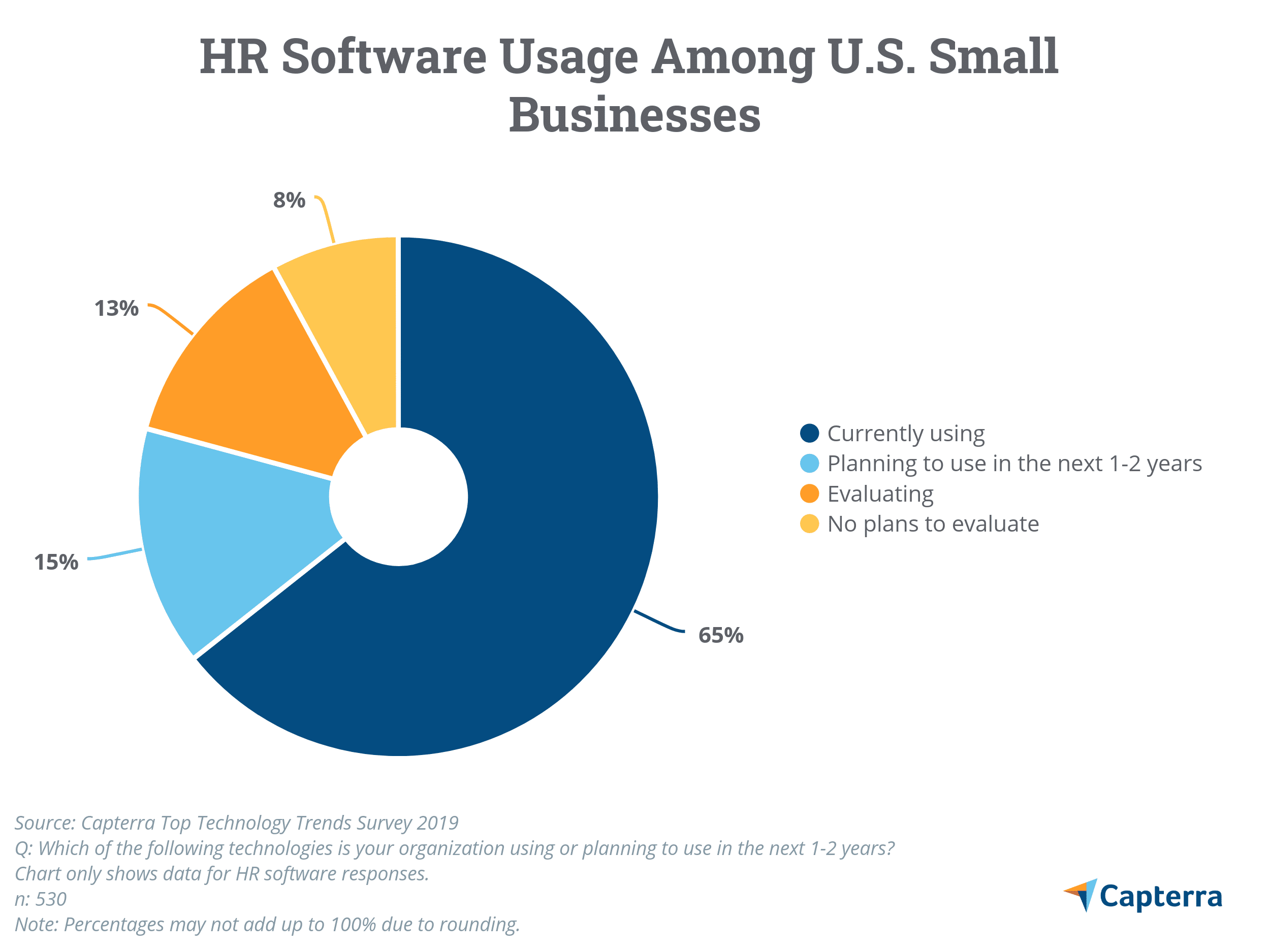
But the digital transformation in human resources doesn’t happen overnight; it requires a detailed strategy and structured implementation. A sloppy attitude towards transformation components may cost a fortune, even to the most progressive financial businesses. Deloitte’s 2021 survey called The social enterprise in the world disrupted highlights one similarity among organizations that appeared to be the best prepared for the Covid-19 crisis. It’s a “thrive” mindset of using disruption as an opportunity to multiply the organization’s success. So let’s figure out what a data-driven journey entails and how HR departments can set out on it.
Table of Contents
What is the value behind digital transformation in human resources?
When treated properly, data-related investments pay dividends quickly. Precise insights into internal operations, rich reporting options, and informed decisions can make the difference for HR departments in financial institutions. So, let’s discuss the most significant benefits of HR digital transformation in more detail.
Decreased risk
Manual information processing is potentially overwhelming for an HR team. Business owners often don’t understand that internal processes are prone to mistakes and that there are many risks buried inside manual spreadsheets.
With an inadequate HR digital transformation strategy, businesses usually go the wrong way and start pushing incremental changes into the spreadsheet solutions. It takes a lot of manual work to streamline the already manual process. To get out of this cycle, companies shouldn’t be afraid to embrace transformation at all levels. Replacing manual processes with software tools and automation solutions reduces human errors and increases productivity.
Maximized results
Workforce analytics allows HR teams to uncover detailed insights into candidate experience, employee engagement, customer satisfaction, and other HR-related facts. These insights may help HR specialists solve a missed-talent issue, which is hunting and hiring external specialists instead of promoting internal experts.
A data-driven approach helps HR departments analyze project performance, gather feedback, and compile realistic employee profiles for better workforce planning. This data-based performance monitoring can also prevent employee burnout and turnover—two costly human resources digital transformation challenges.
Stronger employer brand
One of the benefits of HR digital transformation is a stronger focus on internal culture. Corporate well-being impacts an organization’s future and defines whether it will survive or not, considering an overall talent shortage. According to the recent survey, 58% of respondents believe that finding, attracting, and retaining talents is a top issue, driving HR technology decisions. The company’s culture, if it’s backed by the data-based processes and progressive attitude, correlates directly with an ability to meet employee expectations and to achieve the success of the recruitment strategy.
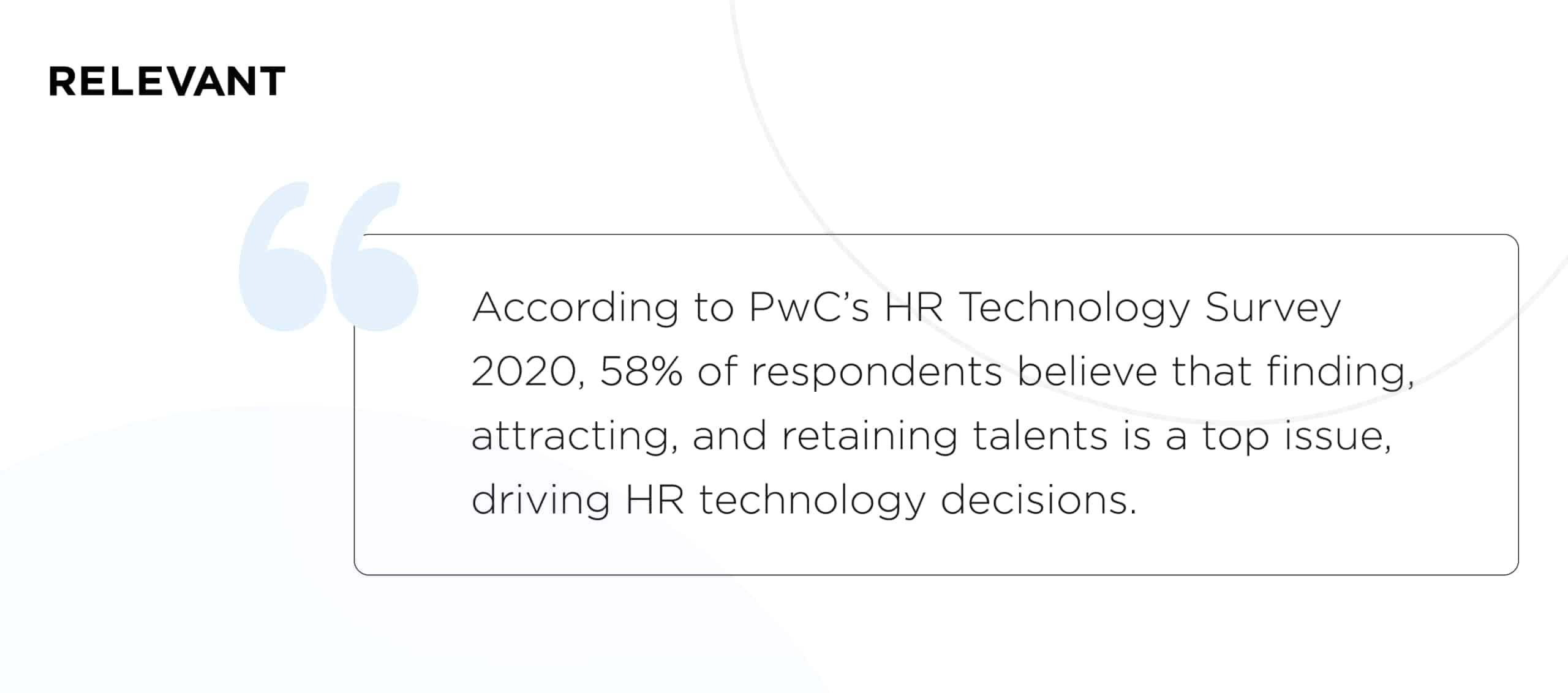
HR digital transformation use cases
Successful HR digital transformation case studies are enhancing the way HR offices work, from recruitment to employee retention and core process automation. But the devil is in the details, so let’s see how exactly financial institutions can rethink their workforce experience to increase HR efficiency.
Recruitment processes
Though HR digital transformation is often perceived as a challenge, it’s more of a lifeline. It reduces tedious tasks so that staff can focus on human relations. Here are examples of HR software that can considerably enhance recruitment processes:
- Recruitment chatbots. Chatbots can save time by handling the majority of standard questions from a recruiter-candidate conversation. They leverage existing data, machine learning, and natural language processing. Many candidates couldn’t even tell that they were interacting with a chatbot.
- AI-powered job posts. Neat, appealing, and professional-looking job posts are equally critical for a brand’s image and attracting qualified candidates. Data-powered tools in this category can, for instance, analyze language patterns to find out which posts are more engaging and provide recruiters with meaningful predictions.
- Onboarding software. Onboarding tools can perform virtual office tours, make personal introductions, or even explain corporate IT structure. It’s very convenient, especially under pandemic conditions, when remote working is often preferred.
- Applicant tracking systems (ATS). This type of software is mainly used to screen CVs and eliminate unqualified ones, sorting out the most appropriate resumes. ATS can also help with job posting, interview planning, and results-evaluation tasks.
Productivity improvements
To improve productivity, HR departments need a perfect picture of what, where, and how to improve. With data analytics tools, HR departments can pull data from multiple sources to get a complete view of an employee’s lifecycle, track the quality of specific HR activities, for example, training programs, better understand employee turnover, and more.
Talent management systems
Being the superhero inside an HR tech stack, talent management systems are a technological suite that ensures effective performance, learning, development, and compensation management. It’s an HR’s right hand throughout the entire journey, from finding the right talent to identifying top performers.
Attrition prediction
Even if employees don’t express the explicit intention to leave the company, there are factors that either indicate hidden plans or stimulate employees to strike out on their own. Data analytics, especially machine-learning techniques, help establish the leading causes of a worker’s decision to leave a company. It also helps to predict whether and when a particular employee is going to quit.
Some of the business owners choose to develop human resource management software. Let us know if you are among them.
HR digital transformation checklist
A journey from paper-based to data-driven management takes time and effort, and it is sometimes full of pitfalls. But how can financial institutions eliminate the biggest stumbling blocks to digital transformation for HR? Compile a digital transformation checklist and stick to it—the more checks you’ll have in the end, the better chances for success.
Here are some of the items that should definitely be on your HR digital transformation checklist.
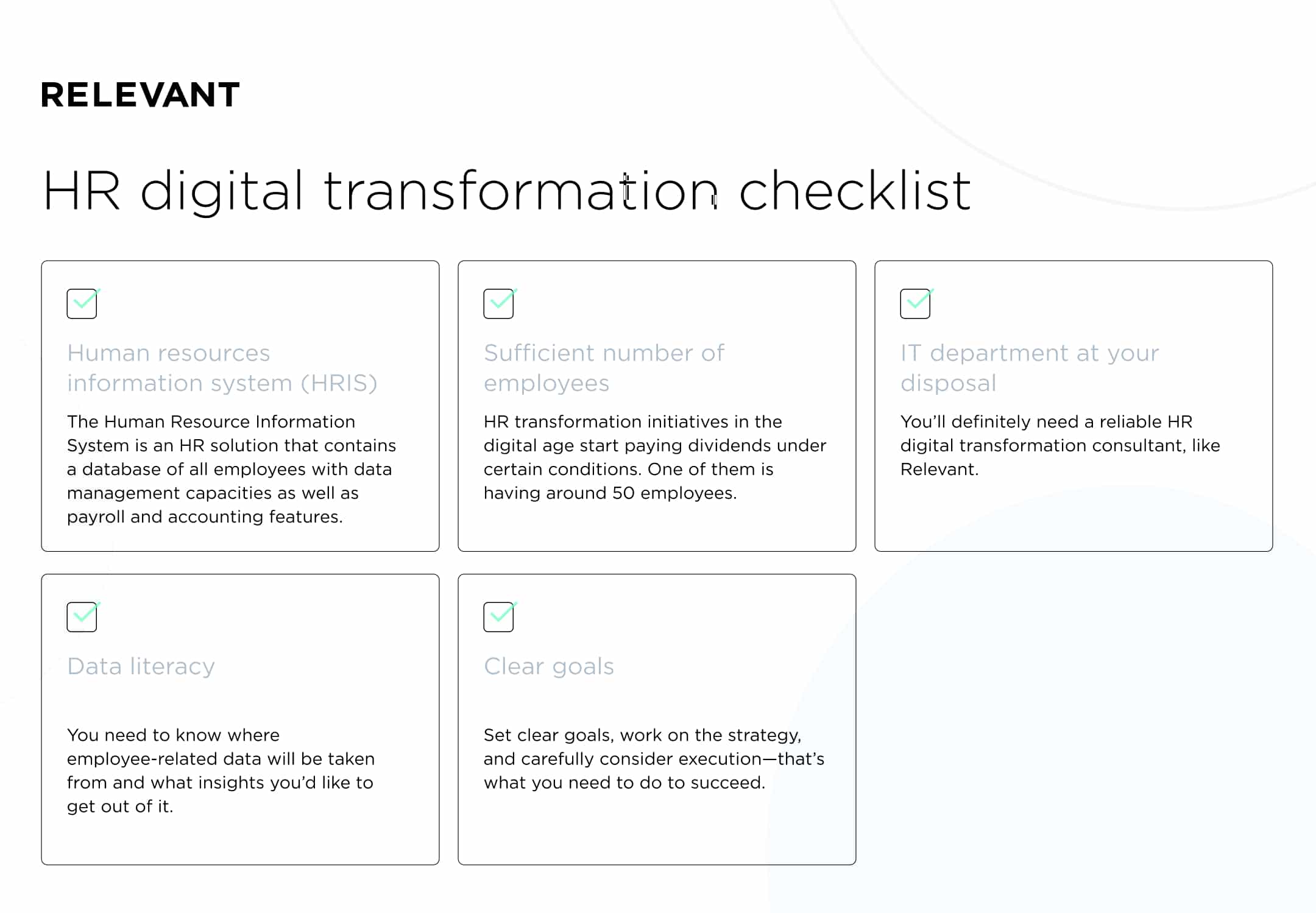
Human resources information system (HRIS)
Any business needs a starting point in its HR digital transformation strategy, and it’s better if that place contains copious amounts of data. HRIS is the right candidate. The Human Resource Information System is an HR solution that contains a database of all employees with data management capacities as well as payroll and accounting features. Having this solid foundation in place is key to informing a successful digital transformation strategy.
Sufficient number of employees
HR transformation initiatives in the digital age start paying dividends under certain conditions. One of them is having around 50 employees. The more employees you have, the bigger administrative load your HR departments will experience. If you successfully manage a happy team of several employees, maybe there is no need to set off on a digital journey just yet.
IT department at your disposal
Usually, it’s a business owner or HR director who is in charge of the transformation. But you’ll definitely need a reliable HR digital transformation consultant. Although you can always rely on third-party experts (who are a good option, by the way), having someone as your technological ally inside the company is a good move.
Data literacy
Although data is ubiquitous, not every manager knows how to deal with it. There are two important steps here. First, you need to know where employee-related data will be taken from and what insights you’d like to get out of it. Second, you need to find a reliable tech partner to help you with the technology stack to support the HR digital transformation strategy.
Clear goals
The FinTech revolution forces the players in the financial industry to compete fiercely, but upgrading your HR department just because everybody does so is not a good idea. Transformation for the transformation’s sake will cost companies time and money but will not necessarily yield positive results. Set clear goals, work on the strategy, and carefully consider execution—that’s what you need to do to succeed.
Stages of digital transformation in HR
Even though every business is different, the process of digital transformation has a lot of common steps. Let’s see what you should do at each stage to replace legacy processes and foster a data-driven culture.
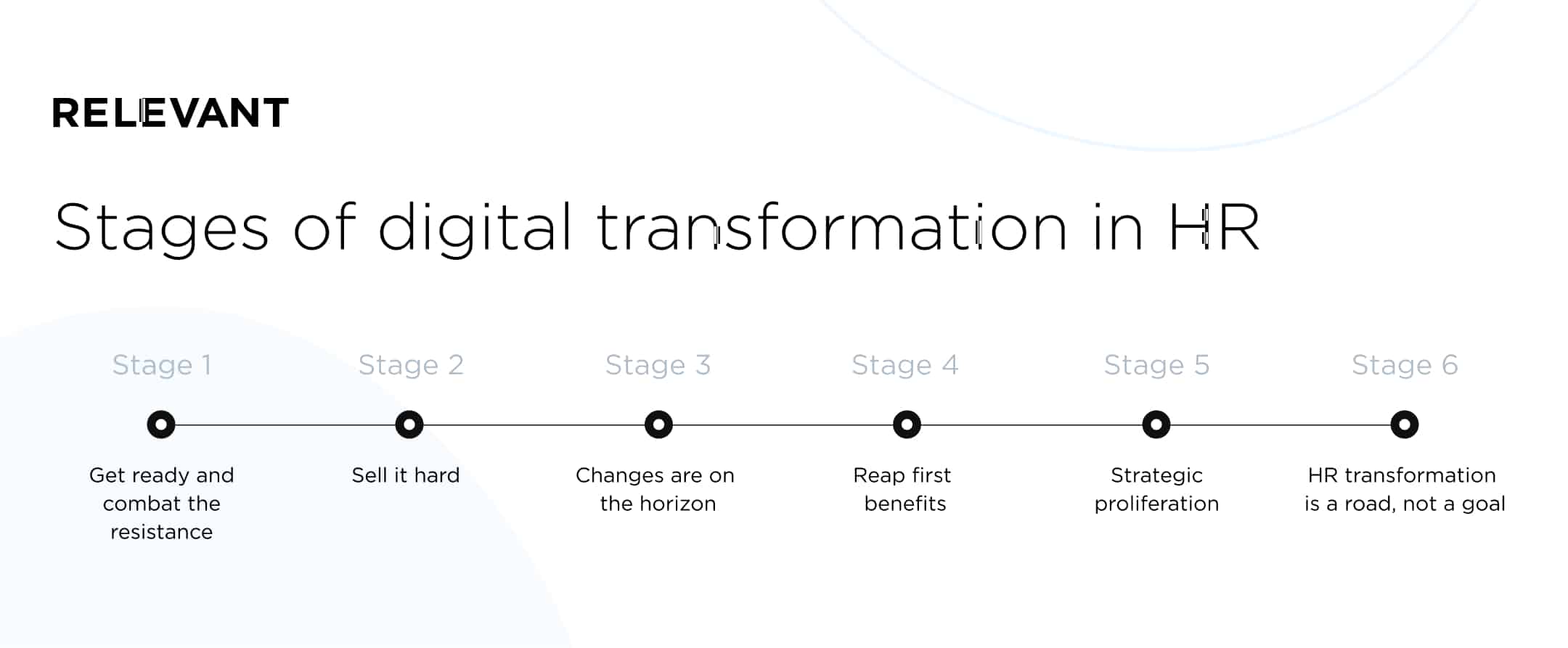
Stage 1: Get ready and combat the resistance
Innovation occurs as a response to disruption, but no one will easily agree to be disrupted. The first stage of HR digital transformation is associated with denial and backlash. When your organization is in this stage, HR processes and people will desperately try to protect their routine. The task of a transformation leader is to be persuasive and focus on the potential positive outcomes.
Check out all the HR processes currently in use and assess them. Identify processes that could be improved by technology solutions and automation. You’ll also need to look at the data you’ll be dealing with and determine its quality.
Find allies by focusing on tech-versed employees and those who are unhappy with the current state of things. Present the majority with successful HR digital transformation examples.
Stage 2: Sell it hard
The stage of acceptance. Once the majority accepts human resources transformation as inevitable, the fierce backlash will start to subside. Sooner or later, people will acknowledge that there is room for improvement, so it’s the right time to showcase the greatest benefits HR digital transformation produces.
Find out who among the top management appreciates your ideas the most and is ready to support you with their authority. It’s high time to create a roadmap and present it to everyone. Focus on the processes that have the most significant business impact and can deliver the best employee experience. Next, think of the technologies you’d like to use, but also consult with technology partners who’ll be able to advise based on their experience.
Stage 3: Changes are on the horizon
At this stage, transformation runs its course, and you can see how legacy technologies and processes are being replaced with advanced systems. Everyone is getting more excited, including your top management ally, who is seeing tangible benefits of HR digital transformation. Present your stakeholders with a timeline for projects and regularly update them with the results.
When a positive outcome is close, it’s essential not to waste any time. Try automating as many steps as possible and free up time for reporting and analytics. Foster collaboration among all the departments involved in the digitalization project.
One more important thing is to prepare people for new systems. Mind that lack of training, failed user expectations, and unclear benefits are the top reasons why HR technologies aren’t embraced. Make sure everyone has the required expertise. So it may be necessary to suggest training programs to cover any skill gaps.
Stage 4: Reap first benefits
At this point, all heavy lifting should have been done. The changes are already implemented and accepted as beneficial. Your IT department should make sure that the existing business tech is connected with the HR tech stack. It’s time to introduce even more sophisticated solutions, like those featuring machine learning or artificial intelligence.
Make sure that employees’ enthusiasm is still high. By now, your HR department should be well-versed in the implemented technologies. Moreover, technological literacy should be a compulsory condition for newly hired HR specialists. Personnel should go on with training for as long as it’s required.
It’s critical to be attentive to regular performance reports and analytical dashboards. If you identify any gaps in business-critical insights, the IT team should close them as soon as possible.
Stage 5: Strategic proliferation
The main tasks at this stage will be focused on high-level planning and intensifying technological components. The goal is to automate as many processes as possible and add sophisticated integrations. For instance, HR solutions should have access to any dataset necessary to make accurate predictions and suggestions. On top of that, continue working with machine learning and deep learning algorithms to make more accurate predictions and provide additional insights.
While the HR digital transformation is ongoing, you’ll have to make sure that every stakeholder is involved and contributes to the new system’s effective functioning. Everyone should be aware of their responsibilities and share their challenges or issues to find the appropriate solutions.
Stage 6: HR transformation is a road, not a goal
Remember that digital transformation in human resources will never be finished. So don’t get too relaxed; instead, think about how to ratchet up the degree of innovation. Now, as your company doesn’t perceive it as intimidating, feel free to experiment and try new tech developments.
Never forget about AI-based solutions. Artificial intelligence will continue to grow in popularity, and it’s an optimal technology to connect HR with an entire organization’s needs and understand the demands of each department. According to Gartner, two-thirds of early AI adopters among HR top managers have up to three ongoing AI projects and plan to double the number by 2022.
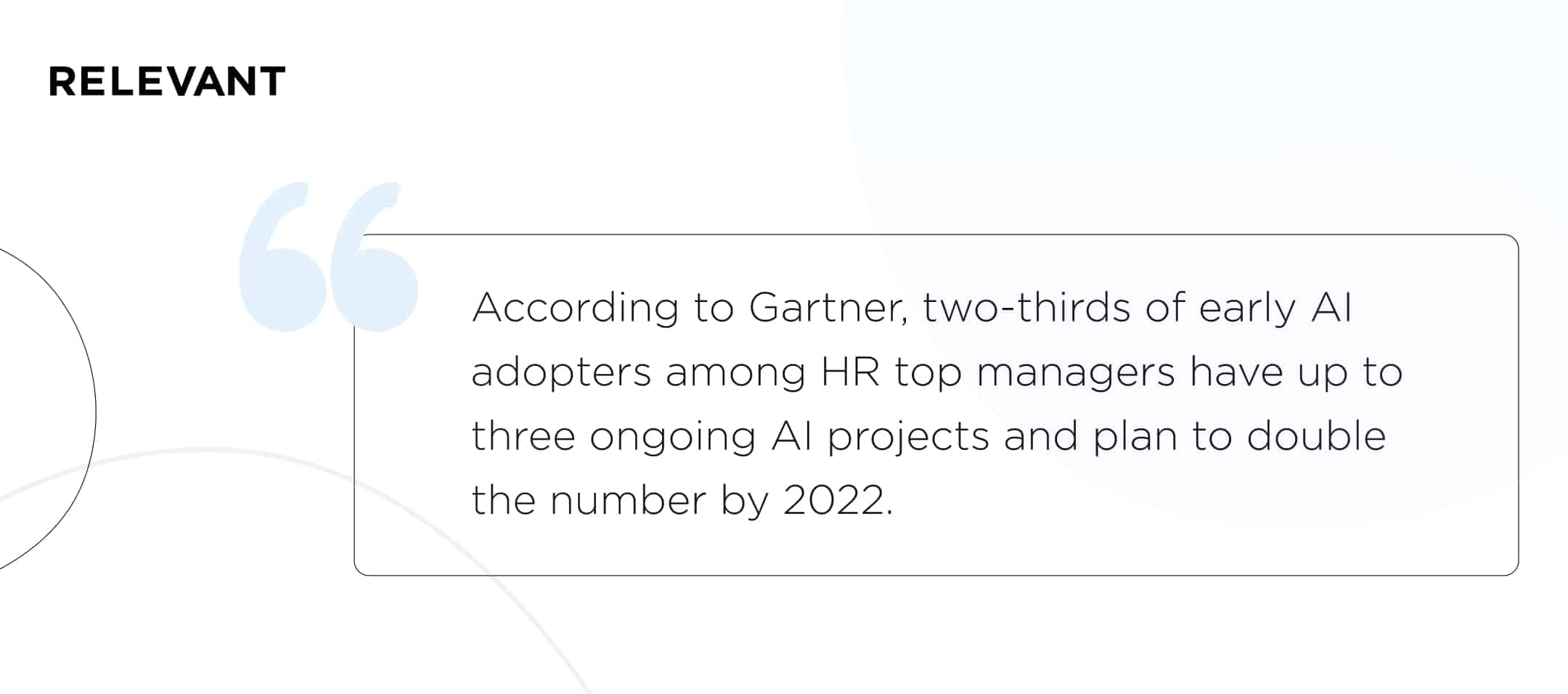
The HR department should be a paragon for innovation and forward-thinking. With benchmarks set high, only supplement the department with enthusiasts with a flair for technology. Special training from time to time can be beneficial to eliminate potential knowledge gaps.
Where to start?
Now that you know all the stages of human resource transformation, it’s time to move towards qualitative change. Carefully think, where are you standing in terms of digital transformation? What goals would you like to achieve as a result of it? What support, particularly technological, will you need to achieve these goals?
HR departments today are under pressure to rewrite the rules, from recruiting and talent practices to performance management. But undertaking transformation tasks single-handedly is a tall order.
At Relevant, we know how to assist businesses at every stage of HR digital transformation. As soon as our clients identify their goals, we suggest the technology and the know-how to fully automate their HR processes. Our shared vision is to turn HR into a business-changing force.
Contact us today!
Our core services:
Do you want a price estimate for your project?
Do you know that we helped 200+ companies build web/mobile apps and scale dev teams?
Let's talk about your engineering needs.
Write to us











